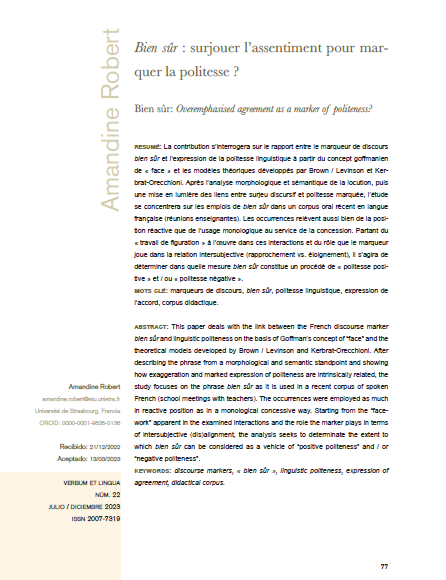Bien sûr : surjouer l’assentiment pour marquer la politesse ?
DOI:
https://doi.org/10.32870/vel.vi22.211Parole chiave:
marqueurs de discours, bien sûr, politesse linguistique, expression de l'accord, corpus didactiqueAbstract
La contribution s’interrogera sur le rapport entre le marqueur de discours bien sûr et l’expression de la politesse linguistique à partir du concept goffmanien de « face » et les modèles théoriques développés par Brown / Levinson et Kerbrat-Orecchioni. Après l’analyse morphologique et sémantique de la locution, puis une mise en lumière des liens entre surjeu discursif et politesse marquée, l’étude se concentrera sur les emplois de bien sûr dans un corpus oral récent en langue française (réunions enseignantes). Les occurrences relèvent aussi bien de la position réactive que de l’usage monologique au service de la concession. Partant du « travail de figuration » à l’œuvre dans ces interactions et du rôle que le marqueur joue dans la relation intersubjective (rapprochement vs. éloignement), il s’agira de déterminer dans quelle mesure bien sûr constitue un procédé de « politesse positive » et / ou « politesse négative ».
Downloads
Metriche
Riferimenti bibliografici
Anscombre, Jean-Claude (2001). À coup sûr, bien sûr. Des différentes manières d’être sûr de quelque chose. In H. Dupuy-Engelhardt, S. Palma & J. E. Tyvaert (Eds), Les phrases dans les textes. Les sons et les mots pour les dire. Les connecteurs du discours. L’opposition verbo-nominale en acte (pp 135-160). Reims : Presses Universitaires de Reims.
Bertrand, Yves (2017). Langue et politesse. Nouveaux Cahiers d’Allemand, 3 : 305-313.
Brown, Penelope / Levinson, Stephen (1978). Universals in Language Usage: Politeness Phenomena. In E. Goody (Ed.), Questions and Politeness: Strategies in Social Interaction (pp. 56-310). Cambridge: Cambridge University Press.
Charaudeau, Patrick / Maingueneau, Dominique (dir.) (2002). Dictionnaire d’analyse du discours. Paris : Editions du Seuil.
Goffman, Erving [1974] (1993). Les rites d’interaction. Paris : Minuit.
Haverkate, Henk (1994). La cortesía verbal. Madrid : Gredos.
ICOR (2013). Convention ICOR. UMR 5191 ICAR (CNRS – Lyon 2 – ENS de Lyon). http://icar.univ-lyon2.fr/projets/corinte/documents/2013_Conv_ICOR_250313.pdf
Kerbrat-Orecchioni, Catherine (1996). La Conversation. Paris : Seuil.
Lambert, Frédéric / Col, Gilles (2020). Les fonctions discursives de voilà : retour sur les valeurs aspectuelles et déictiques de voilà en emploi absolu. In G. Col, C. Danino et S. Bikialo, Polysémie, usages et fonctions de « voilà » (pp. 123-151). Beihefte zur Zeitschrift für romanische Philologie, Volume: 427. De Gruyter.
Lefeuvre, Florence (2021). Analyse outillée du marqueur discursif bien sûr. L’information grammaticale. halshs-03355115
Rabatel, Alain (2012). Ironie et sur-énonciation. Vox Romanica, 71 : 42-76.
Rey, Alain (2000). Dictionnaire historique de la langue française. Paris : Dictionnaire Le Robert.
Robert, Amandine (2021). Corpus oral personnel. Exemples de la contribution consultables à l'adresse https://seafile.unistra.fr/d/058299f6008b4dc0b2fb/
Schneider-Mizony, Odile (2018). L’argumentation véridictionnelle. Nouveaux Cahiers d’Allemand, 2 : 149-163.

Downloads
Additional Files
Pubblicato
Versioni
- 2024-08-30 (2)
- 2023-07-01 (1)












